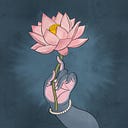Vārāhī
Gurjara-Pratihara Style
9th century, British Museum
This sculpture is from the Gurjara-Pratihara dynasty, known for the sculptures and open pavilion style temples (such as Khajuraho and the Bateshwar temples) that were built during this period. The founders of this dynasty, who ruled from Ujjain and Kannauj: the Gurjars were (probably) originally a tribe from eastern Rajasthan and the Pratiharas considered themselves descendants of Lakshmana. It is believed that it was the might of the Gurjara-Pratihara army effectively barred the progress of the Arab invasion beyond the confines of Sindh. In light of later events, this may be regarded as the “chief contribution” of the Gurjara-Pratiharas to the history of India (aside from their art and architecture of course).
Vārāhī (वाराही) is one of the ‘divine mothers’ (mātṛ) or Mātṛkā-Śaktis created by Rudra for the purpose of drinking the blood of Andhakāsura and destroying the clones that sprang from his blood.
Andhakāsura attempted to abduct Girājanandinī (Pārvatī) and thus ensued a fierce battle between Andhakāsura and the great Rudra, the Lord of Umā. Like raktabīja, every drop of blood that fell from the body of Andhaka created another Asura warrior like him and in no time, the entire world was filled with Andhakas. To destroy the growing number of Andhakas, Rudra created innumerable Mātṛkā-Śaktis [including Goddess Vārāhī]. These Śaktis of immense power at once began to drink every drop of blood that flowed from the body of Andhaka, but they could still not effectively contain the emergence of more and more demons.
According to the Matsya-purāṇa: “Most terrible they (the Vārāhī) all drank the blood of those Andhakas and become exceedingly satiated.”
Vārāhī is depicted with the face of a boar and having dark complexion resembling the storm cloud.
In the Raktabīja episode of Dēvi purāṇa, Vārāhī is described as having a boar form, fighting demons with her tusks while seated on a Preta (ghoul). She has a big belly and six hands, in four of which she carries the danda (staff of punishment), khetaka (shield), khadga (sword), and pasha (noose); while the two other hands gesture Abhaya and Varada mudras.
In this exquisite Nepali bronze, the objects in three of her four hands reference the countercultural tantric Hindu practices of drinking liquids from a bowl made from a skull cap (kapāla). The fish implies the consumption of illicit food, and the snake pertains to the noose that keeps one bound in fear that leads to inevitable death.
Sources:
- History of Ancient India: Earliest Times to 1000 A.D. By Radhey Shyam Chaurasia
2. Puranic Encyclopedia Vettam Mani
______________________________________________________________
If you find value in my work, I hope you consider becoming a patron through Patreon. Hindu Aesthetic requires a lot of time and effort and your support would mean that I can continue bringing you the highest quality content. Link to my Patreon:
